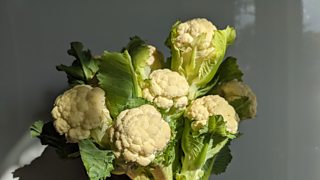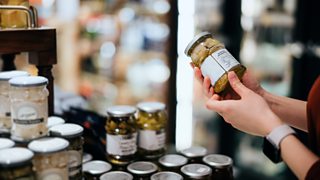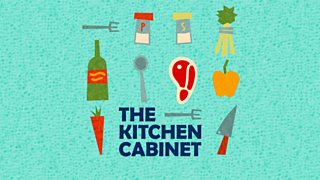Veg invention: the new fruit and veg coming to your plate
Where do new varieties of fruit and veg come from? Who invents them? Why do we need them?
Seed breeders spend whole careers in search of that perfect fruit or vegetable, and some even come up with their own completely new designs. Think Tenderstem (cross between a traditional broccoli and a type of Chinese kale), Cotton Candy grapes, or a new type of cauliflower that's hitting our shelves: CauliShoots.
In The Food Programme, Leyla Kazim finds out what goes into creating these new varieties, what breeders, growers, and supermarket buyers are looking for, and how they end up on our plates.
The Food Programme
-
![]()
The Food Programme
Investigating every aspect of the food we eat
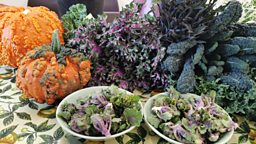
What is plant breeding for?
Jamie Claxton, Director of Breeding at Tozer Seeds, explains: “It’s improving plants. Producing new traits to make plants easier to grow, more nutritious, less problems with disease.”
The growers “will often see things in the field where they’re having problems,” says Jamie, and might ask if he and his colleagues can produce a variety that gets around it. This might be “a slightly different plant habit that makes it easier for harvesting,” for example.
And as well as breeding varieties of lots of common vegetables like leeks, cauliflowers or pumpkins, they’re also developing completely new ones.
Kalettes
It was Jamie who first came up with the idea of the kalette: a cross between a kale and a Brussels sprout. Instead of the round buttons of Brussels sprouts, you’ve got little rosettes growing up a central stem. Initially they were given the name “flower sprouts”, but they found sales weren’t as good!
We do quite a lot of blue-sky breeding, where we just try whacky stuff and see what happens.Jamie Claxton
How did the idea of the kalette come about?
“We do quite a lot of blue-sky breeding, where we just try whacky stuff and see what happens,” says Jamie. They were experimenting with the whole brassica family, because they knew they would cross pollinate easily and create unusual veg. The aim was to create something “more modern,” he says. “Brussels sprouts and kale are very traditional.”
Some other whacky hybrids are in the pipeline too. “A bit like the kalette, we’re trying crosses with the cavolo nero, to get miniature cavolo nero rosettes all the way up the stem,” says Jamie.
“We have looked at other things like crossing a Brussels sprout with a cauliflower, thinking you might get little baby cauliflowers up the stem, although that’s definitely work in progress!” he laughs. “It doesn’t always play ball, plant breeding.”
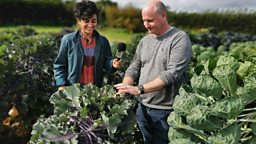
Caulishoots
CauliShoots is a new brand of vegetable that only came out in August 2021. They’re about five or six inches long, with a green stem, at the end of which is a little cauliflower floret. They don’t need much prep as you can eat all parts of it. They’re nutty, sweet, and taste much like a standard cauliflower.
“A CauliShoot is a plant which grows like a standard cauliflower but before it gets to the cauliflower size you take it out and then side shoots of smaller cauliflowers come from the plant,” explains Emma Lilley, an agronomist from veg growers Barfoots, the company responsible for bringing this vegetable to the UK market.

Cotton Candy grapes
Cotton Candy is a variety of grape that was originally bred in America because it’s super sweet and “tastes like you’ve been to the fairground,” says Andrew Mellonie, Senior Agronomist at Marks and Spencer.
“That variety probably started being bred about 25 years, maybe twenty years ago,” he says. The breeder crossed traditional table grapes with wine making varieties of grapes. “Literally probably thousands of crosses were made to select that particular one that gave that flavour.”
How are hybrid plants created?
There are two types of seed variety. One is the open-pollinated seed derived from a population of very similar individuals. Insects will cross pollinate from all the different plants, which are very similar. And you can grow them on from the seed you save.
It can take up to ten years to create, refine and develop them into a marketable product.Jamie Claxton
And then there are F1 hybrids, which are quite different. “An F1 hybrid is a controlled cross between two uniform parent lines,” explains Jamie from Tozer. Parent A and parent B will both be uniform (which means when you sow all the seeds, the plants look the same), but the two parent plants themselves are different. For a kalette, for example, parent A is a Brussels sprout and parent B is a kale. “You cross pollinate the two, and the seed you get from pollination is the F1 hybrid seed.”
“Because you started from uniform parents, the hybrid is really uniform,” says Jamie, “and it has the advantage of being extremely vigorous. You get what’s called hybrid vigour.”
The downside? “You’ll find that F1 hybrid seed is a lot more expensive to buy in the garden centre than the old open-pollinated varieties, because the process of producing them is so painstaking.” It can take up to ten years to create, refine and develop them into a marketable product.
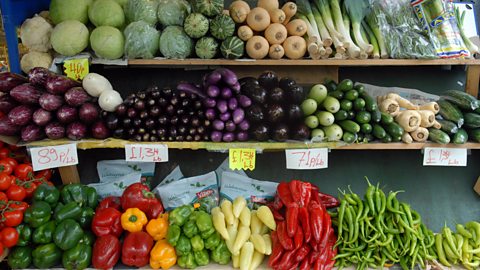
The vegetable parts you shouldn't be throwing away
Do you chop off certain bits of vegetables and throw them away?
What do these novel types of fruit and veg bring to our plate?
Chef Jack Stein has been cooking up some of the whackier new varieties of veg.
I don’t think the cucamelons ever really took off like we thought they were going to.Jack Stein
“As a chef you get a sense of things that you think are going to work really well,” he says. But he isn’t always right. Something called an “electric daisy,” that numbed your mouth a bit like a Sichuan peppercorn was just “too much” he admits. “I don’t think the cucamelons ever really took off like we thought they were going to,” he adds. But certain things like the kalette and amazing rainbow-coloured kales have. “You look at them in the shop and it just brightens up the place, and it’s the same with a plate of food in the restaurant.”
When he’s looking at new veg, there are certain traits he’s after. “Obviously it’s going to be down to taste really, and it’s going to be down to what it looks like on the plate, so the colour, the texture, the taste – all these things are really important.” But novelty is also a big part of the appeal.
A lot of these new varieties are patented and trademarked
To breed a new variety takes a lot of effort and a lot of expense. Breeders don’t want to see the variety being picked up by their competitors and copied, says Andrew Mellonie. “So, the breeder will often have plant-breeders rights to the variety.” This means that genetically, they own it, and no one else can produce the seeds. “The breeder will sell the seeds often to grower partners because to grow it to its best ability, which shows off its attributes to the customer, takes a great deal of skill,” says Andrew.
But not everyone agrees that this protection and ownership is fair. US chef Dan Barber set up an organic seed company to bring breeders, chefs and farmers together to design new, better varieties of veg. At Row 7, they are well known for not patenting the seeds.
“We don’t believe that biological life should be owned by anyone. When you tie up genes, or combinations of genes, you’re preventing another breeder from using that for something else,” Dan argues. “That cuts back on the opportunity to develop these new varieties that are more responsive to the kind of environment we want and the kind of vegetables and grains that give us the kind of nutrient density that we desperately need.”
For Dan, companies owning varieties of plants is not the way forward: “That’s not the future of a vibrant, successful food supply.”
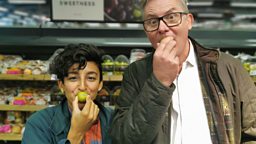
What does the future of veg look like?
A current conversation in the world of veg breeding is around gene editing, where a plant’s DNA is manipulated to behave in a certain way. What will it mean for new varieties of fruit and veg in the future?
It’s not just about making quirky new kales... it’s about feeding the world.Jamie Claxton
“That’s a process that’s going to massively speed up the process of plant breeding,” says Jamie of Tozer. It’s not GMO (where other material is inserted into a plant’s DNA), it’s just gene editing, where specific genes are altered. It would be possible to add in things like drought tolerance, which could greatly help developing countries. “So, it’s not just about making quirky new kales,” he says, “it’s about feeding the world.”
“There’s some really exciting things coming,” says Andrew of M&S. New fruit and veg is without doubt an increasing trend, he says, with new breeding techniques making it quicker to breed than ever before. And what will we see more of? “Things that are convenient and easy to prepare,” he suggests. “The sweet stem cauliflower’s a good example.” And we’ll see more and more crossing varieties. “In stone fruit you can cross varieties to produce hybrids of apricots and plums and that’s really exciting,” he says.
Who knows what the next horticultural hybrid phenomenon will be? Watch this space…

-
![]()
Listen to Veg Invention: The stories of new kinds of fruit and vegetables
Leyla Kazim finds out what goes into creating these new varieties, what breeders, growers and supermarket buyers are looking for, and how they end up on our plates.

More of Radio 4 served up on a plate
-
![]()
The Food Programme
Investigating every aspect of the food we eat
-
![]()
Ultra-processed vegan and vegetarian foods: are they as healthy as they look?
Ultra-processed vegan and vegetarian foods may look healthy, but are they? James Gallagher investigates.
-
![]()
The Kitchen Cabinet
Jay Rayner hosts a culinary panel show packed full of tasty titbits that might change the way we think about food, cooking and eating.
-
![]()
Just One Thing - with Michael Mosley: Change Your Mealtimes
Sometimes it’s not what you eat that matters, but when you eat. Michael reveals just how much mealtimes matter when it comes to health.
